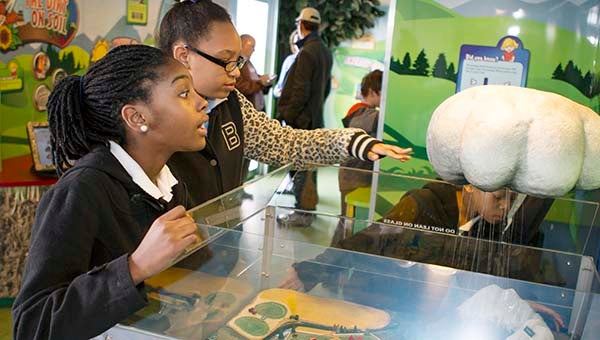Seed Survivor puts fun in lessons on plant life
Published 10:32 am Wednesday, February 18, 2015

Latavia Picot, left, and Jada Person, both 11, interact with one of the lesson stations in Seed Survivor. — Cain Madden | Tidewater News
FRANKLIN
Many students at S.P. Morton Elementary were treated recently to a series of interactive games, but not just for the sake of having a good time. Instead, they learned the importance of seeds, soil, sunlight, water and nutrients, and how those ingredients work together in creating the food needed to live and grow.
Bringing those lessons in plant nutrition was Seed Survivor, a mobile unit that’s been traveling to elementary schools in Western Tidewater for the past few weeks. Instrumental in arranging a visit to SPM was Teri Pittman, assistant principal.
“I read up on it, and it seemed like a really good program,” she said. “It’s hands-on science. I love that they brought it here. It’s an awesome opportunity for students.”
Seed Survivor is going all over the state, and schools can register online to arrange a visit. Agrium, which is a plant nutrient company based in the Alberta province of Canada, provides the units; these were designed and launched in 2005. The Virginia Farm Bureau was also key in sponsoring the program to go through the commonwealth.
Supervising the local stopover was Rex Cotten, who knows a thing or two about agriculture. He had retired a few years ago after working several years as a Virginia Tech extension agent in Suffolk.
“I’m one of the teachers,” Cotten said about his role, which includes raising the level of understanding of agriculture. When it comes to knowing the source of their food, he said, “children in this area have a little advantage.”
But children from larger urban settings, not so much.
“They think food grows in stores,” he said and gave as an example of meeting some children in Richmond who think that peanuts grow on trees or bushes.
“Our agricultural knowledge base — it’s not a good thing,” Cotten said.
The lessons that students get about plants, seeds and life cycles are all part of their curriculum of learning science.
“It’s an awesome way of pulling that together for the science portion of SOL [tests],” Pittman said.
“These SOL efforts show up,” Cotten added.
Inside Seed Survivor, students from Wanda Green’s fifth-grade class went back and forth from station to station, testing their knowledge of seeds and plants.
“I didn’t know that much before,” said Jada Person, 11, as she read a monitor about nitrogen.
But a personal interest in life sciences is growing, and she’s thinking now about becoming a marine biologist.
Nearby, Jaylin Bailey, 11 and Devin Deshields, 10, were playing a game of trying to make plants grow with the right amount of water and nutrients.
Latavia Picot, 11, played a different activity of trying to make plants have more water so they won’t die.
“I knew just a little bit before this,” she said about the subject.
Paris Banks and Taniya Benn, both 10, said they knew the basics of plants, and even had a plant sale recently.
Benjy Kerbaugh, 11, got a lesson in harvesting from the unit’s activities.
To reinforce what the students have been learning, Cotten gave a brief lecture summarizing the lessons.
For example, he showed how only 3 percent of the earth is available for growing food and raising livestock for seven billion people.
Further, that one in seven Americans works in agriculture, but less than 2 percent are involved in actual growing.
Holding up different containers of sand, silt and clay, Cotten explained that these three create loam, a soil that’s found in this area.
He also showed jars that had nitrogen, potassium and phosphorus, all crucial to nurturing seeds to becoming plants.
Finally, each student got their own cups to fill with soil and two sunflower seeds, complete with instructions on how to grow their flowers.
Educational, interactive activities for students and resources for teachers are available at www.seedsurvivor.com. For other information, visit www.growingthenextgeneration.com or www.agrium.com.





